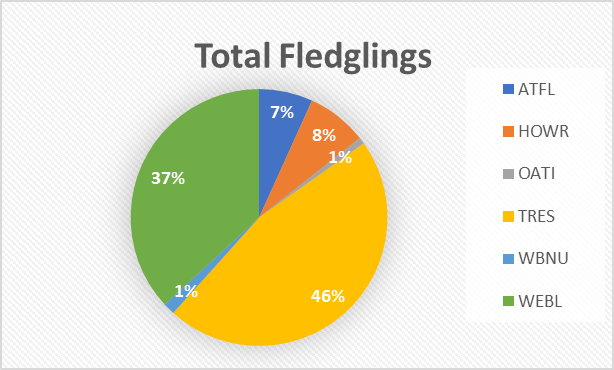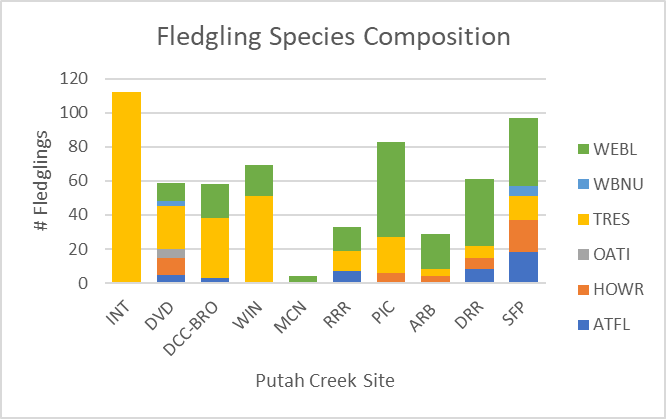It was a productive and exciting season on the Putah Creek Nestbox Highway. We had appearances by six different cavity nesting songbird species, each bringing their best to the chick-rearing game. These species (in order of their fledgling production numbers) were Tree Swallow (TRES), Western Bluebird (WEBL), House Wren (HOWR), Ash-Throated Flycatcher (ATFL), Oak Titmouse (OATI) and White-Breasted Nuthatch (WBNU). Tree
Swallows led the charge with a whopping 281 chicks successfully fledging from the nest boxes. Their massive success could be attributed to their early domination of the Interdam (INT) site, rearing nearly 40% of all Tree Swallow fledglings produced overall (and excluding all other species from that site). Our runner-up in the race to reproduction were the charismatic and hearty Western Bluebirds, producing a total of 223 fledglings across the ten Putah Creek sites. Across all sites and species, a total of 605 birds fledged from the Putah Creek Nestbox Highway.

| Site Name | Site Code |
| Interdam | INT |
| Diversion Dam | DVD |
| Dry Creek Confluence | DCC-BRO |
| Winters Putah Creek Park | WIN |
| McNamara Triangle Orchard | MCN |
| Russel Ranch | RRR |
| Picnic Grounds | PIC |
| Aboretum | ARB |
| Old Davis Road/Restoria | DRR |
| South Fork Preserve | SFP |
While slightly slacking in the fledgling-production department, Western Bluebirds threw down an impressive number of fully constructed nests with eggs- outbuilding Tree Swallows 98 to 92. The drop to third place was hefty, with Ash-Throated Flycatchers producing just 12 nests. However, they did not disappoint in the egg-to-fledge department. With a 72% success rate, Ash-Throated Flycatchers far surpassed the dismal 51% and 58% fledge rates by Western Bluebirds and Tree Swallows.

2023 winter and spring weather was protracted cold and wet which likely impacted resident and early breeding species more than migratory Ash-throated Flycatchers. Moreover, a recent multi-year PCNH study found that nesting season precipitation significantly lowered reproductive outcomes for WEBL and TRES but significantly increased fledging success for ATFL (Riggio et al. Cons. Bio. 2023).

Of the 173 boxes available for occupation on Putah Creek, 159 (92%) were in-use this season. The boxes deemed “prime real estate” by their avian residents often housed multiple clutches. Some boxes, like DRC8 (at Old Davis Road/Restoria (DRR)), had three nest attempts by two different species! Specific sites showed variation in the percentage of occupied boxes, however. South Fork Preserve (SFP), Interdam (INT), and McNamara’s Triangle Orchard (MCN) had nesting attempts in every available box, while sites like Arboretum (ARB) and Diversion Dam (DVD) only had 72% and 74% occupancy rates. In the case of McNamara, all the orchard trees were cut down prior to the nesting season and the resulting competitive market led to very low fledgling success. On the other hand, both Interdam and South Fork Preserve had relatively high fledge success.

On the egg-laying front, a pair of Western Bluebirds took the “Early Bird” award by plopping down an egg in the chilly hours of April 10th at Winters Putah Creek Park (WIN). Despite their accomplishments, however, and in comparison to last year’s first egg date, the “Early Bird” WEBLs were quite late. (The 2022 nesting season began nearly a month prior with a pair of WBNU laying the first of seven (!) eggs at DVD.) As mentioned above, the winter of 2023 proved to be long and chilly, resulting in a delayed season start and fewer overall nestlings produced. In addition to fewer eggs being laid, the nestlings had a 10% lower survival rate in 2023.
Nevertheless, we cannot discount the pair of Oak Titmice that quickly followed suit on April 11th at Diversion Dam. This sentinel egg-laying event put Diversion Dam on the path towards becoming the most diverse site in 2023; successfully housing six different species! While no other site even came close to Diversion Dam in the diversity department, they were successful in their own ways.
Winters Putah Creek Park takes the podium for WEBL nestling survival. With 100% of hatchlings surviving to fledge, WIN is deemed “Safest Place to Raise a Family”. On the flip side, the high levels of interspecific competition and predation at McNamara Ranch make for a less than ideal chick-rearing environment. While all boxes at MCN had nesting and egg laying attempts, only four chicks successfully fledged. That site was chock-full of disappearing chicks, evictions, and take-overs. As a result, the few remaining boxes at MCN have been decommissioned, and the boxes will be made available at different (and less deadly) sites. We cannot discuss nest box evictions without an honorable mention of “The Rat That Persisted”. Upon making a new home in an old House Wren nest at DRR, this stubborn rodent resisted eviction three times!
Moving onto individual accomplishments, we must mention the “Father of the Season”. This individual was banded as an adult at Russell Ranch in 2022. In 2023, “SvGN OEGN” was a part of the only Western Bluebird pair to have three clutches!

Of the 807 nestlings produced by the Putah Creek Nestbox Highway in 2023, 668 were banded by the UC Davis MWFB Nestbox Interns and affiliated biologists. In past years, our banded birds have been spotted along Putah Creek and in Davis, Winters and beyond. This year, we received a resighting report of a female Western Bluebird on Road 29, our farthest reported dispersal yet! She was about five miles from her original box in the Picnic Grounds. Resight information can help us learn about the life history and dispersal of our local birds. If you’ve seen one of our banded birds, please report it here!
It has been a very egg-citing first season as the Putah Creek Biologist, and I am looking forward to next year!
-Amanda Kindel
